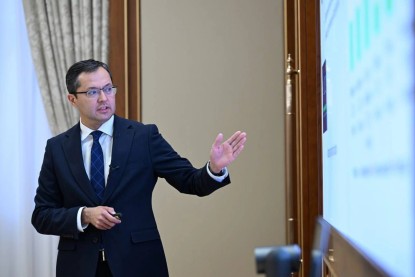The Ministry of Finance of Uzbekistan has developed a draft concept for development of the Uzbekistan’s financial markets for medium and long term. The document is published on the portal for discussion of normative legal acts.
Experts from the Korean Stock Exchange, UNDP, the International Finance Corporation, the Institute for Forecasting and Macroeconomic Research under the Cabinet of Ministers and other bodies participated in the drafting of the concept.
Stock Market Review
The authors of the draft acknowledge that the current state of Uzbekistan’s stock market leaves much to be desired. The stock market In Uzbekistan emerged following mass privatization in the 1990s of state-owned enterprises through their conversion into joint-stock companies, with their stakes sold to company staff and investors. The reorganizations were carried out by forming of authorized capital divided by shares on the basis of their assets.
Today there are 624 JSCs in the country. Among the shareholders thre are about 900,000 natural and legal persons owning 42.1 trillion soums worth of shares at a face value. There are 80 legal entities that provide intermediary consultants and management services in the stock market. A single software and hardware complex for the stock market was launched in September 2016 jointly with the Korean Stock Exchange. Since then, the number of transactions has doubled.
In 2016, the total turnover of corporate securities (shares and bonds) was at 14.5 trillion soums, or 7.3% of the country's GDP. For comparison (World Bank information), by the end of 2015 this figure averaged 133.8% in the Korea Republic , 127.1% in Japan, 48.7% in Turkey, 43.8% in Germany, 8.6% in Russia.
The average daily turnover on Toshkent Stock Exchange in 2016 was only US$ 325 thousand against 22.9 billion dollars on Tokyo Stock Exchange, 2.1 billion dollars on the Istanbul Exchange, 1.13 billion dollars on Moscow Stock Exchange and 0.7 billion dollars on the Kazakhstan Stock Exchange.
At the beginning of 2017, the market capitalization of Toshkent SE was about 2.1 billion dollars or less than 3% of GDP, whereas in the world this indicator is on average 82%.
The volumes and share of the secondary securities market remain insignificant. Over the past nine years, only in 2011, the share of the secondary market exceeded the 50 percent bar from the total stock market, accounting for 57.7 percent. During 2007-2010, the share of the secondary market for equity securities did not exceed 40% of the total turnover.
"The current situation on the stock market, in particular, on the secondary market, is the evidence of the failure by Uzbek capital market to perform its main duty which is to ensure financing of the real sector by attracting investments from individuals and investors, including foreign investors," the draft concept notes.
The main reasons restraining the development of financial markets are their excessive sensitivity to privatization processes, the organizational structure of regulating that does not meet modern standards, unreasonably high thresholds for joint-stock companies, and the lack of a balanced approach in reforming the financial markets.
Investment intermediaries providing brokerage, market-making and management services are the small enterprises, that have no network of branches throughout the country.
Tapping the financial markets potential will reduce the burden on the state budget and bank lending, create a healthy competitive environment in the financial sector and improve the quality of financial services provided to individuals, the document says.
The development of the stock market will also contribute to improving corporate governance in JSCs, which will significantly reduce abuses by company officials and violations of rights and interests of shareholders, especially minority shareholders.
Proposals for development of financial markets
To implement the concept, it is proposed to approve a Financial Market Comprehensive Development Program for 2017-2021. It provides for the improvement of the legal and regulatory framework for securities markets, insurance and banking services, introduction of new financial instruments, institutional strengthening of the financial market regulation system, and others.












